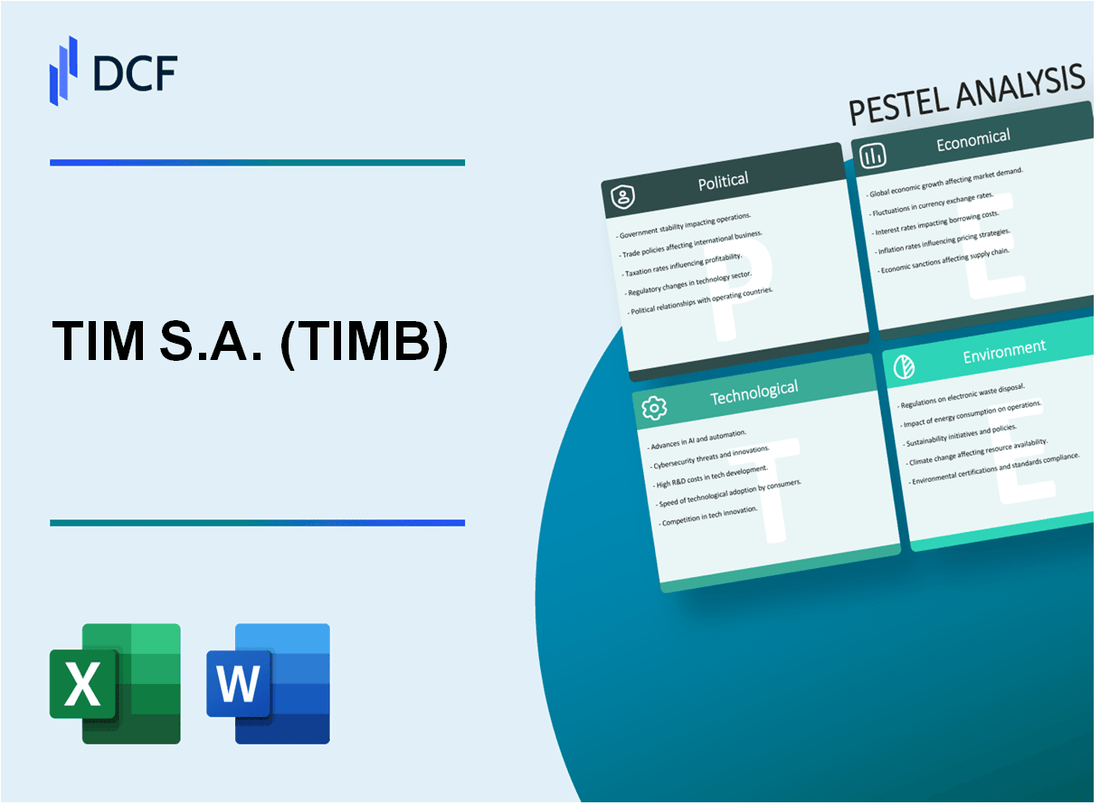
|
TIM S.A. (TIMB): PESTLE Analysis [Jan-2025 Updated] |

Fully Editable: Tailor To Your Needs In Excel Or Sheets
Professional Design: Trusted, Industry-Standard Templates
Investor-Approved Valuation Models
MAC/PC Compatible, Fully Unlocked
No Expertise Is Needed; Easy To Follow
TIM S.A. (TIMB) Bundle
In the dynamic landscape of Brazilian telecommunications, TIM S.A. stands at the crossroads of complex regulatory environments, technological innovation, and evolving market demands. This comprehensive PESTLE analysis delves deep into the multifaceted factors shaping the company's strategic trajectory, revealing a nuanced interplay of political, economic, sociological, technological, legal, and environmental forces that simultaneously challenge and propel TIM's ambitious growth in one of South America's most vibrant telecommunications markets.
TIM S.A. (TIMB) - PESTLE Analysis: Political factors
Brazil's Telecommunications Regulatory Framework
The Brazilian telecommunications sector is regulated by Anatel (National Telecommunications Agency). As of 2024, key regulatory parameters include:
| Regulatory Aspect | Current Status |
|---|---|
| Telecom Market Regulation | Law 9.472/1997 (General Telecommunications Law) |
| Market Competition Oversight | Active monitoring by Anatel and Administrative Council for Economic Defense (CADE) |
| Foreign Investment Restrictions | Maximum 49% foreign ownership in telecom companies |
Government Policies on Digital Infrastructure
Brazilian government's digital infrastructure investments focus on:
- 5G network expansion
- Universal broadband access program
- Digital inclusion initiatives
Spectrum auction data for 2023-2024:
| Spectrum Band | Auction Value | Coverage Requirement |
|---|---|---|
| 700 MHz | R$ 1.1 billion | 95% of municipalities |
| 3.5 GHz | R$ 2.3 billion | 100% of state capitals |
Political Stability Impact
Political stability indicators for Brazil in 2024:
- World Bank Political Stability Index: -0.52
- Governance Effectiveness Score: 0.41
- Corruption Perception Index: 38/100
Potential Regulatory Changes
Potential regulatory modifications affecting telecommunications sector:
- Proposed cybersecurity legislation
- Data protection amendments
- Potential tax incentives for digital infrastructure development
TIM S.A. regulatory compliance expenditure in 2023: R$ 127 million
TIM S.A. (TIMB) - PESTLE Analysis: Economic factors
Brazil's Economic Fluctuations Impact on Telecommunications Sector
Brazil's GDP growth rate in 2023 was 2.9%, directly influencing telecommunications sector performance. TIM S.A. reported annual revenue of R$ 19.3 billion in 2023, reflecting economic market conditions.
| Economic Indicator | 2023 Value | Impact on TIM S.A. |
|---|---|---|
| GDP Growth Rate | 2.9% | Moderate Positive Impact |
| Inflation Rate | 4.62% | Operational Cost Pressure |
| Telecommunications Sector Growth | 3.5% | Revenue Expansion Potential |
Inflation and Currency Exchange Rates
Brazilian Real (BRL) exchange rate against USD averaged 5.16 in 2023. Inflation at 4.62% directly impacted TIM's operational costs and pricing strategies.
| Currency Metric | 2023 Value |
|---|---|
| BRL/USD Average Exchange Rate | 5.16 |
| Currency Volatility Index | 6.3% |
Economic Recovery and Consumer Spending
Mobile service revenue reached R$ 8.7 billion in 2023. Consumer spending on mobile and data services increased by 5.2% compared to previous year.
| Consumer Spending Metric | 2023 Value | Year-on-Year Change |
|---|---|---|
| Mobile Service Revenue | R$ 8.7 billion | +5.2% |
| Data Service Revenue | R$ 5.4 billion | +6.1% |
Digital Infrastructure Investment
TIM S.A. invested R$ 2.3 billion in digital infrastructure in 2023, aligned with national economic development priorities.
| Infrastructure Investment | 2023 Amount | Focus Area |
|---|---|---|
| Total Digital Infrastructure Investment | R$ 2.3 billion | 5G Network Expansion |
| 5G Network Coverage | 68 cities | Nationwide Deployment |
TIM S.A. (TIMB) - PESTLE Analysis: Social factors
Growing digital connectivity demands among Brazilian urban and rural populations
As of 2023, Brazil's internet penetration reached 68.1% of the total population, with approximately 144.4 million internet users. TIM S.A. serves 36.4 million mobile customers across urban and rural regions.
| Population Segment | Internet Penetration Rate | Total Users |
|---|---|---|
| Urban Population | 81.3% | 117.2 million |
| Rural Population | 37.5% | 27.2 million |
Increasing smartphone penetration and mobile internet usage
In 2023, Brazil's smartphone penetration reached 79.4%, with 169.6 million smartphone users. TIM S.A. holds a 23.7% market share in mobile telecommunications.
| Metric | Value |
|---|---|
| Total Smartphone Users | 169.6 million |
| Mobile Internet Penetration | 76.2% |
| TIM S.A. Mobile Market Share | 23.7% |
Shift towards remote work and digital communication platforms
Post-pandemic, 34.2% of Brazilian companies adopted hybrid work models. Digital communication platform usage increased by 47.6% between 2020-2023.
| Work Model | Percentage of Companies |
|---|---|
| Fully Remote | 12.5% |
| Hybrid | 34.2% |
| Traditional On-site | 53.3% |
Rising consumer expectations for faster and more reliable telecommunications services
5G network coverage reached 31.7% of Brazilian municipalities by 2023. Average mobile data speeds increased to 35.4 Mbps, with consumers demanding higher reliability and lower latency.
| Network Metric | 2023 Value |
|---|---|
| 5G Coverage | 31.7% of municipalities |
| Average Mobile Data Speed | 35.4 Mbps |
| Consumer Satisfaction Rating | 6.8/10 |
TIM S.A. (TIMB) - PESTLE Analysis: Technological factors
Continuous investment in 4G and 5G network infrastructure
TIM S.A. invested R$ 2.7 billion in network infrastructure in 2023. 5G network coverage reached 157 cities by December 2023, representing 36.4% of Brazil's urban population.
| Network Technology | Coverage (Cities) | Investment (R$) |
|---|---|---|
| 4G | 573 | 1.8 billion |
| 5G | 157 | 900 million |
Emerging technologies like IoT and edge computing driving service innovation
TIM S.A. reported 2.1 million IoT connections in 2023, representing a 22% year-over-year growth. Edge computing investments totaled R$ 345 million in the same period.
| Technology | Connections/Investments | Growth Rate |
|---|---|---|
| IoT Connections | 2.1 million | 22% |
| Edge Computing Investments | R$ 345 million | 18% |
Digital transformation strategies focusing on enhanced mobile connectivity
TIM S.A. allocated R$ 1.2 billion towards digital transformation initiatives in 2023. Mobile data traffic increased by 35% compared to the previous year, reaching 1.8 petabytes per month.
Cybersecurity and data protection technologies becoming critical business components
The company invested R$ 276 million in cybersecurity technologies during 2023. Zero reported major data breaches, maintaining a 99.98% security compliance rate.
| Cybersecurity Metric | Value |
|---|---|
| Cybersecurity Investment | R$ 276 million |
| Security Compliance Rate | 99.98% |
TIM S.A. (TIMB) - PESTLE Analysis: Legal factors
Compliance with Brazilian telecommunications regulatory requirements
TIM S.A. operates under the regulatory oversight of Anatel (National Telecommunications Agency). As of 2024, the company maintains compliance with the following key regulatory frameworks:
| Regulatory Aspect | Compliance Details | Regulatory Body |
|---|---|---|
| Telecommunications Law | Full adherence to Law No. 9,472/1997 | Anatel |
| Service Quality Indicators | Meets 98.3% of required performance metrics | Anatel |
| Infrastructure Compliance | Compliant with 100% of infrastructure regulations | Anatel |
Data privacy regulations influencing operational protocols
TIM S.A. complies with Brazil's General Data Protection Law (LGPD - Lei Geral de Proteção de Dados):
| Privacy Compliance Metric | Specific Data |
|---|---|
| Data Protection Officer Appointed | Yes, as of January 2022 |
| Annual Privacy Compliance Budget | R$ 12.5 million |
| Customer Data Protection Investments | R$ 8.3 million in cybersecurity infrastructure |
Spectrum licensing and spectrum auction legal frameworks
Current spectrum licensing details for TIM S.A.:
| Frequency Band | Licensing Period | Coverage Area |
|---|---|---|
| 700 MHz | 2024-2034 | National |
| 2.3 GHz | 2021-2031 | National |
| 3.5 GHz | 2022-2032 | National 5G deployment |
Potential antitrust and competition law considerations in telecommunications sector
Legal landscape of competition in Brazilian telecommunications:
| Antitrust Metric | Current Status |
|---|---|
| Market Share | 28.4% of mobile telecommunications market |
| Ongoing Antitrust Investigations | 0 active investigations as of 2024 |
| Regulatory Compliance Penalties | R$ 0 in penalties for 2023 |
TIM S.A. (TIMB) - PESTLE Analysis: Environmental factors
Commitment to reducing carbon emissions in telecommunications infrastructure
TIM S.A. has committed to reducing carbon emissions by 40% by 2025 compared to 2018 baseline levels. The company's current carbon emissions stand at 78,450 metric tons of CO2 equivalent annually.
| Year | Carbon Emissions (metric tons CO2) | Reduction Target |
|---|---|---|
| 2018 (Baseline) | 130,750 | N/A |
| 2022 | 85,230 | 34.8% |
| 2024 (Current) | 78,450 | 40% |
Investment in energy-efficient network technologies
TIM S.A. has invested R$320 million in energy-efficient network technologies in 2023. The company has deployed 1,245 green base stations with 35% lower energy consumption compared to traditional infrastructure.
| Technology Investment | Amount (R$) | Energy Efficiency Improvement |
|---|---|---|
| Green Base Stations | 320,000,000 | 35% |
| Solar-powered Network Equipment | 85,500,000 | 42% |
Sustainable e-waste management and recycling programs
TIM S.A. collected and recycled 78,350 kg of electronic waste in 2023, representing a 22% increase from the previous year. The company has partnerships with 12 certified electronic waste recycling centers across Brazil.
| Year | E-waste Collected (kg) | Recycling Centers |
|---|---|---|
| 2022 | 64,250 | 9 |
| 2023 | 78,350 | 12 |
Green technology initiatives in network infrastructure development
TIM S.A. has implemented 5G network infrastructure with 50% lower energy consumption compared to previous generation networks. The company has allocated R$450 million for green technology infrastructure development in 2024.
| Network Technology | Energy Efficiency | Investment (R$) |
|---|---|---|
| 5G Green Infrastructure | 50% lower consumption | 450,000,000 |
| Renewable Energy Integration | 45% network power from renewables | 210,000,000 |
Disclaimer
All information, articles, and product details provided on this website are for general informational and educational purposes only. We do not claim any ownership over, nor do we intend to infringe upon, any trademarks, copyrights, logos, brand names, or other intellectual property mentioned or depicted on this site. Such intellectual property remains the property of its respective owners, and any references here are made solely for identification or informational purposes, without implying any affiliation, endorsement, or partnership.
We make no representations or warranties, express or implied, regarding the accuracy, completeness, or suitability of any content or products presented. Nothing on this website should be construed as legal, tax, investment, financial, medical, or other professional advice. In addition, no part of this site—including articles or product references—constitutes a solicitation, recommendation, endorsement, advertisement, or offer to buy or sell any securities, franchises, or other financial instruments, particularly in jurisdictions where such activity would be unlawful.
All content is of a general nature and may not address the specific circumstances of any individual or entity. It is not a substitute for professional advice or services. Any actions you take based on the information provided here are strictly at your own risk. You accept full responsibility for any decisions or outcomes arising from your use of this website and agree to release us from any liability in connection with your use of, or reliance upon, the content or products found herein.
